 When is a terrible movie a must-watch? When it stars Ursula Andress. 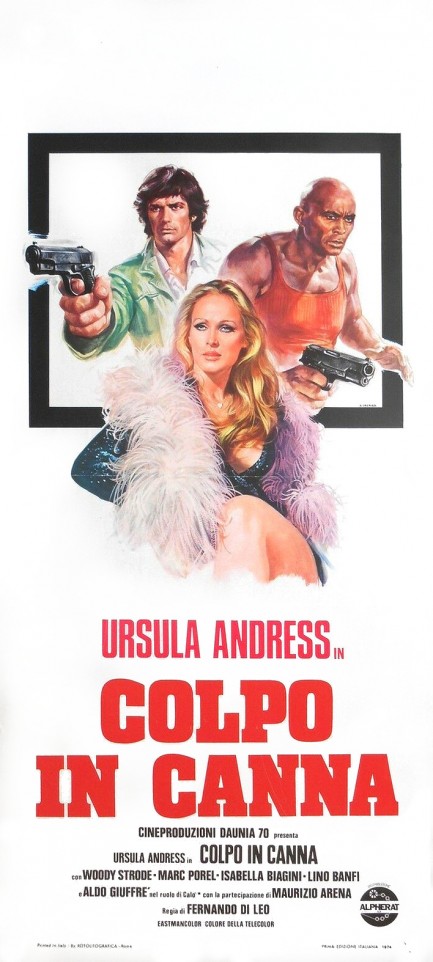
Colpo in canna, for which you see a promo poster above, starred Swiss goddess Ursula Andress during the height of her nudie period, as you'll soon see. She plays a flight attendant paid by a stranger to deliver a note. Sounds legit, right? She has no idea she's delivering this message to criminals. These crooks don't react well. They rough her up and force her to act as bait to find the writer of the note, but she hooks up with a hot circus acrobat who lends a hand—and his bed—as Andress is chased all over Naples by two gangs and the cops.
Crowdsourced sites like IMDB call Colpo in canna an action adventure, which is why we watched it. But it's actually an action comedy, and anything ostensibly comedic from Italy during the 1970s should strike fear into your heart. That fear will be realized, as ludicrous oompah brass music and ragtime numbers accompany pratfall interludes and fights played for laughs. It's torturous.
The only reason to endure this patchwork of stolen Benny Hill routines is for Andress, who most people would be happy to stare at for hours fully clothed, but who here, at thirty-nine years old and looking as breathtaking as ever, has five—or was it six?—nude scenes. In the same way a milkshake is just a delivery system for a sugar high, this film is just a delivery system for an Andress high. She'll leave you dizzy, possibly even stunned. Colpo in canna, which was known in English as Loaded Guns, premiered in Italy today in 1975             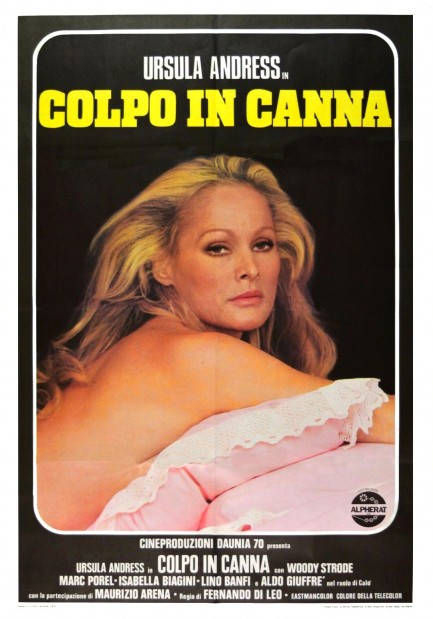
 Don't worry. Lava's slow. I'm fast. I'll undress, we'll screw, then we'll run for our lives. 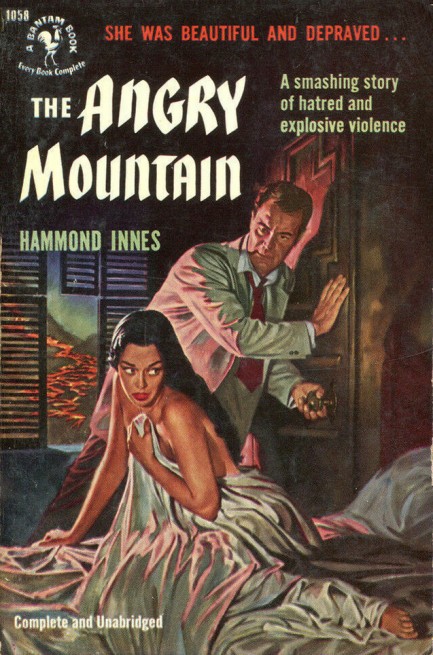
When we lived in Central America there were three volcanoes that loomed over our town. One's slope commenced just a few miles away and its peak dominated the sky to the south, but that one was extinct. The other two were not. One was dormant, but the other was active and smoked nonstop, with the prevailing wind carrying the ash away from town. This mountain occasionally shot out fountains of lava hundreds of feet high, which is a sight that will make you realize how insignificant you are the same way seeing a tornado or massive wave will. These mountains stood sentinel over many of our adventures, and were even involved in a few, including the time we visited a village on the extinct volcano and a mob of about thirty people beat a suspected thief to death.
Another time the top of that volcano started glowing red one night when we were hanging out at one of the local bars. We stood in the street with our drinks watching this spectacle, and pretty soon we could see flames around the mountain's peak. We thought we were seriously screwed. It was always understood that if that dead volcano ever came back to life there was nothing to do but kiss your ass goodbye. We decided to redouble our drinking. It turned out the flames were caused by a forest fire way up by the rim, but we gotta tell you, in those moments when we thought we might be toast, we got very efficiently hammered. It's a great memory, standing in that cobbled colonial lane, guzzling booze and waiting for the mountain to blow us all to hell.
Needless to say, for that reason the cover of 1952's The Angry Mountain by Hammond Innes sold us. The art is by Mitchell Hooks and it's close to his best work, we think. We didn't need to know anything about the book. We just wanted to see how the author used a volcano—specifically Vesuvius—in his tale, since they're a subject personal to us. The cover scene does occur in the narrative, though the couple involved aren't actually trying to have sex. Innes describes this lava lit encounter well. In fact we'd say it's described beyond the ability of even an artist as good as Hooks to capture, but that doesn't mean the book is top notch. Innes simply manages to make the most of his central gimmick.
The narrative deals with a man named Farrell who was tortured during World War II, losing his leg to a fascist doctor who amputated without anesthesia. A handful of years later Farrell is in Europe again, getting around on a prosthetic leg, when a series of events leads to him believing the doctor who tortured him is alive and living under a false identity. In trying to unravel this mystery he travels from Czechoslovakia, to Milan, to Naples, and finally to a villa at the foot of Vesuvius, along the way being pursued but having no idea why. He soon comes to understand that he's thought to be hiding or carrying something. But what? Why? And where? Where could he be carrying something valuable without his knowledge? Well, there's that hollow leg of his he let get out of his sight one night when he got blackout drunk...
That was a spoiler but since you probably don't have a volcano fetish you aren't going to seek out this novel, right? The main flaw with The Angry Mountain is that, ironically, there's not much heat. Farrell is an alcoholic and has PTSD, so he's not an easy protagonist to get behind. And his confusion about what's happening gives the first-person narrative the feel of going around in circles much of the time. And because this is a 1950s thriller, there's the mandatory love interest—or actually two—and that feels unrealistic when you're talking about a one-legged boozehound who has nightmares, cold sweats, and general stability problems. So the book, while evocative, is only partly successful. But those volcano scenes. We sure loved those.
 Hah hah, don't worry about my gun. Worry about my mood. 
Above, a photo of German actress and dancer Taina Béryl, aka Taina Beryll, aka Tayna Beryll, happily playing with a sidearm, which given a choice is better than her unhappily playing with it. Her name is often spelled "Tania" around the internet but that's incorrect. As a dancer Taina-not-Tania Béryl performed at the Teatro San Carlo in Naples, and in cinema was seen in such productions as Une blonde comme ça, L'inconnue de Hong Kong, and Berlin, cites with los Espias. 1963 on the image.
 It sounds nice but it isn't all it's cracked up to be. 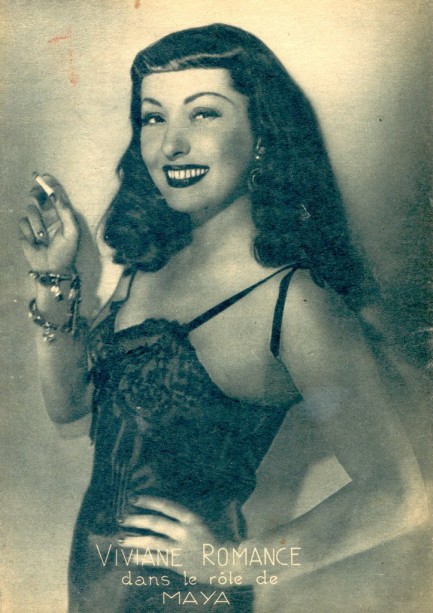
A couple of days ago we did a post of Mexican film magazines and basically, we knew none of the cover stars. But we were curious, especially about the interestingly named Viviane Romance, and decided to dig a bit more deeply. Born Pauline Arlette Ortmans in France in 1912, her career began in 1925 at age thirteen, when she danced at the Sarah Bernhardt Theatre in Paris. The next year she scored a spot as a Moulin Rouge dancer, and at sixteen moved on to dance at the famed Bal Tabarin nightclub. At eighteen she entered and won the Miss Paris pageant but was stripped of her title when she was found to be pregnant. This loss of her crown, while doubtless dismaying for Romance, also generated public recognition that she parlayed into a film role in 1935’s Princess Tam Tam, in which starred American dancer Josephine Baker. In 1936’s La belle équipe, she played the role of a young woman who destroyed the friendship of co-stars Jean Gabin and Charles Vanel. The film was a hit, and a series of bad girl roles followed in Naples au baiser de feu, La Maison du Matais, Prisons de femmes and Le puritain. She had become one of cinema’s first femmes fatales. When the German army swept into France in May 1940, Romance found herself caught in a dilemma. The Nazis were eager to create a veneer of normalcy. That meant they were willing to allow the French film industry to function, though under the auspices of their Propagandastaffe, which would censor any content deemed disrespectful or harmful toward Germany. Faced with the choice of working for the Nazis or retiring—which might not have been allowed without serious consequences—Romance chose to continue performing, and starred in Vénus aveugle, Feu sacre, Une femme dans la nuit, and Cartacalha, reine des gitans. In the last, she sang the hit song “Chanson gitane (Sur la route qui va).” aveugle, Feu sacre, Une femme dans la nuit, and Cartacalha, reine des gitans. In the last, she sang the hit song “Chanson gitane (Sur la route qui va).” It’s worth pointing out that Romance wasn’t alone in her decision to perform for the Nazis. Many of France’s top stars, including Danielle Darrieux, Junie Astor, René Dary, Suzy Delair, Albert Préjean and others did the same. In select instances, some type of pressure was brought to bear. For instance, in Darrieux’s case, the Nazis had imprisoned her husband Porfirio Rubirosa, and her acting was the price for his freedom. At the same time, it should also be noted that many French actors made the choice to ignore the plight of their Jewish compatriots. The Germans banned Jews from any participation in cinema, and the workers who remained were required to carry cards affirming their non-Jewishness. Thus while the genocidal extent of Nazi plans may not have been crystal clear to some actors, the intent to—at a minimum—erase Jews from public life was certainly no secret. But Romance and others performed anyway. And of course, giving the Nazis an inch meant they would take a mile. Ever vigilant for propaganda opportunities, party officials pressured Romance, Darrieux and the other actors into traveling to Germany for a highly publicized visit to several Berlin film studios. Newspapers and newsreels touted the appearances in a blatant attempt to burnish the Nazis artistic bona fides. For the segment of French citizenry opposed to the occupation, the actors had crossed the line. It was one thing to continue working—everyone needed to do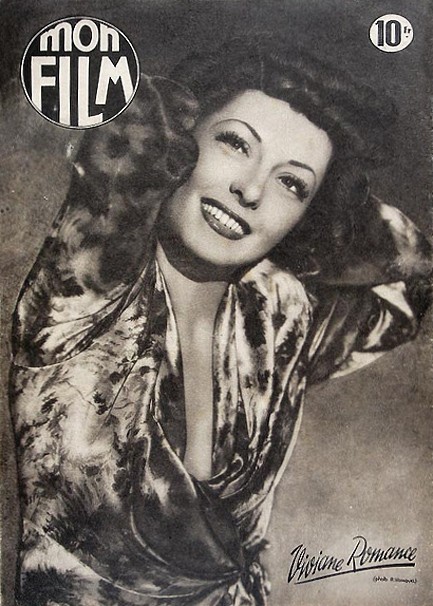  that. But to allow themselves to be used to legitimize the Nazi agenda was an entirely different story. When the Germans were finally expelled from France in 1944, Romance was thrown in jail. We don’t have much information about this event. We can only say she was eventually forgiven—officially at least—for what many perceived as her feeble level of the resistance to the Nazis. that. But to allow themselves to be used to legitimize the Nazi agenda was an entirely different story. When the Germans were finally expelled from France in 1944, Romance was thrown in jail. We don’t have much information about this event. We can only say she was eventually forgiven—officially at least—for what many perceived as her feeble level of the resistance to the Nazis. After the war, Romance immersed herself in work, making eight movies in the next three-plus years. In 1949 she played the role of Bella in the film Maya, for which you see the promo art at top. Her performance was lavishly reviewed—she was the toast of Paris again. Romance worked steadily through the next decade until her star began to dim in the early 1960s. She grappled with financial difficulty in the mid-1960s, and at one point had to sell off her possessions to survive. She made her last film, Nada, in 1974, and died in 1991 in Nice, on France’s Côte d’Azur, at age seventy-nine. It would be journalistically tidy to write that Viviane Romance lived a life that somehow embodied her stage surname, but it would also be glib and untrue. The scandal of unwed motherhood, the climb up the ladder while still just a teenager, the shadow of Nazism over the prime of her career, her stint behind bars—none of it can be romanticized. Nor can her three failed marriages. If anything, Romance was like the narrator of the song she once memorably performed, “Chanson gitane.” That woman was strong enough to pass “with a noise of horses” but fragile as “a shiver of tinsel.” Ultimately Romance's story mirrors that of many women who survived dangerous times. They had to be tough, smart, and pragmatic—then when order returned they had to be judged on their failings and hope for forgiveness. that somehow embodied her stage surname, but it would also be glib and untrue. The scandal of unwed motherhood, the climb up the ladder while still just a teenager, the shadow of Nazism over the prime of her career, her stint behind bars—none of it can be romanticized. Nor can her three failed marriages. If anything, Romance was like the narrator of the song she once memorably performed, “Chanson gitane.” That woman was strong enough to pass “with a noise of horses” but fragile as “a shiver of tinsel.” Ultimately Romance's story mirrors that of many women who survived dangerous times. They had to be tough, smart, and pragmatic—then when order returned they had to be judged on their failings and hope for forgiveness.
 If sex sells, pretending sex is bad sells even better. 
Here’s another Vice Squad magazine, published this month in 1964, with cover star Sophia Loren and several other interesting offerings. You’ll notice the banner about bare-bosom bikinis. Believe it or not, back in the mid-sixties bikini evolution reached a point where bras vanished entirely. The most famous of these suits were known as topless Maillots, and Vice Squad breathlessly claimed they were popular with liberated young women on the beaches of Saint Tropez. As far as their popularity Stateside, we weren’t around yet, so we can’t say with certainty whether they were widely worn. However, we did find a 1964 photo at bikiniscience of a brave Chicago woman named Toni Lee Shelley being hustled away by a local cop after wearing a topless Maillot on North 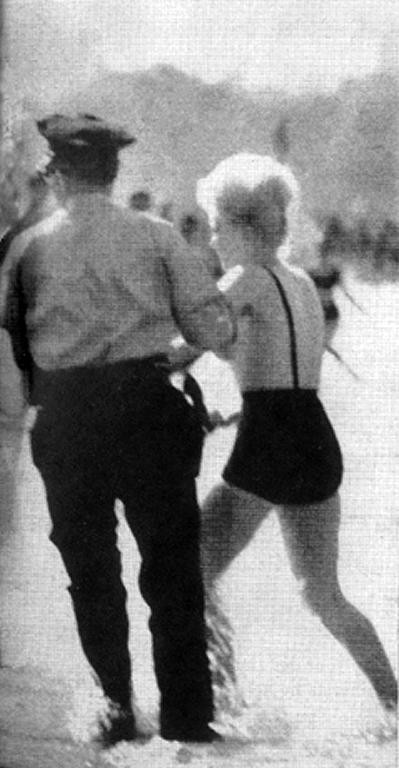 Beach. Interesting, isn’t it, that the same thing would probably happen today, half a century later? (At Pulp we tend to snicker about this, because on our beaches many sunbathers go entirely nude—and we wish most of them would cover up). Beach. Interesting, isn’t it, that the same thing would probably happen today, half a century later? (At Pulp we tend to snicker about this, because on our beaches many sunbathers go entirely nude—and we wish most of them would cover up). Anyway, the leering tone of Vice Squad’s text (along with censored pix) was designed to inflame the magazine’s mainly conservative readers while giving them involuntary stirrings in the pants. Imagine thousands of Archie Bunkers getting heated up over the magazine’s scandalous contents, slamming it down in disgust, then sneaking a closer look after the missus had gone to bed. The same formula is at work in the stories about beauty queens, the “mink and champagne girl,” and Sophia Loren, who is pictured here in her film Leri, oggi, domani, aka, Yesterday, Today and Tomorrow. Loren was always dogged by rumors that she turned to prostitution briefly during the dismal post-war years in Naples, when she was a teenager. The Vice Squad story, while not going that far, certainly suggests that Loren was a bit of a wild child. We can’t say if she was ever a member of the world’s oldest profession, but we can definitely say Vice Squad editors were experts at another ancient endeavor—spreading vicious rumors. That said, if any proof exists that the great Sophia Loren was a lady of the night, we’d pay to see it. How does fifty bucks sound?
|
 |

The headlines that mattered yesteryear.
1933—The Gestapo Is Formed
The Geheime Staatspolizei, aka Gestapo, the official secret police force of Nazi Germany, is established. It begins under the administration of SS leader Heinrich Himmler in his position as Chief of German Police, but by 1939 is administered by the Reichssicherheitshauptamt, or Reich Main Security Office, and is a feared entity in every corner of Germany and beyond. 1937—Guernica Is Bombed
In Spain during the Spanish Civil War, the Basque town of Guernica is bombed by the German Luftwaffe, resulting in widespread destruction and casualties. The Basque government reports 1,654 people killed, while later research suggests far fewer deaths, but regardless, Guernica is viewed as an example of terror bombing and other countries learn that Nazi Germany is committed to that tactic. The bombing also becomes inspiration for Pablo Picasso, resulting in a protest painting that is not only his most famous work, but one the most important pieces of art ever produced. 1939—Batman Debuts
In Detective Comics #27, DC Comics publishes its second major superhero, Batman, who becomes one of the most popular comic book characters of all time, and then a popular camp television series starring Adam West, and lastly a multi-million dollar movie franchise starring Michael Keaton, then George Clooney, and finally Christian Bale. 1953—Crick and Watson Publish DNA Results
British scientists James D Watson and Francis Crick publish an article detailing their discovery of the existence and structure of deoxyribonucleic acid, or DNA, in Nature magazine. Their findings answer one of the oldest and most fundamental questions of biology, that of how living things reproduce themselves. 1967—First Space Program Casualty Occurs
Soviet cosmonaut Vladimir Komarov dies in Soyuz 1 when, during re-entry into Earth's atmosphere after more than ten successful orbits, the capsule's main parachute fails to deploy properly, and the backup chute becomes entangled in the first. The capsule's descent is slowed, but it still hits the ground at about 90 mph, at which point it bursts into flames. Komarov is the first human to die during a space mission.
|

|
|

It's easy. We have an uploader that makes it a snap. Use it to submit your art, text, header, and subhead. Your post can be funny, serious, or anything in between, as long as it's vintage pulp. You'll get a byline and experience the fleeting pride of free authorship. We'll edit your post for typos, but the rest is up to you. Click here to give us your best shot.

|
|





















 aveugle, Feu sacre, Une femme dans la nuit, and Cartacalha, reine des gitans. In the last, she sang the hit song “Chanson gitane (Sur la route qui va).”
aveugle, Feu sacre, Une femme dans la nuit, and Cartacalha, reine des gitans. In the last, she sang the hit song “Chanson gitane (Sur la route qui va).”
 that. But to allow themselves to be used to legitimize the Nazi agenda was an entirely different story. When the Germans were finally expelled from France in 1944, Romance was thrown in jail. We don’t have much information about this event. We can only say she was eventually forgiven—officially at least—for what many perceived as her feeble level of the resistance to the Nazis.
that. But to allow themselves to be used to legitimize the Nazi agenda was an entirely different story. When the Germans were finally expelled from France in 1944, Romance was thrown in jail. We don’t have much information about this event. We can only say she was eventually forgiven—officially at least—for what many perceived as her feeble level of the resistance to the Nazis. that somehow embodied her stage surname, but it would also be glib and untrue. The scandal of unwed motherhood, the climb up the ladder while still just a teenager, the shadow of Nazism over the prime of her career, her stint behind bars—none of it can be romanticized. Nor can her three failed marriages. If anything, Romance was like the narrator of the song she once memorably performed, “Chanson gitane.” That woman was strong enough to pass “with a noise of horses” but fragile as “a shiver of tinsel.” Ultimately Romance's story mirrors that of many women who survived dangerous times. They had to be tough, smart, and pragmatic—then when order returned they had to be judged on their failings and hope for forgiveness.
that somehow embodied her stage surname, but it would also be glib and untrue. The scandal of unwed motherhood, the climb up the ladder while still just a teenager, the shadow of Nazism over the prime of her career, her stint behind bars—none of it can be romanticized. Nor can her three failed marriages. If anything, Romance was like the narrator of the song she once memorably performed, “Chanson gitane.” That woman was strong enough to pass “with a noise of horses” but fragile as “a shiver of tinsel.” Ultimately Romance's story mirrors that of many women who survived dangerous times. They had to be tough, smart, and pragmatic—then when order returned they had to be judged on their failings and hope for forgiveness. 

 Beach. Interesting, isn’t it, that the same thing would probably happen today, half a century later? (At Pulp we tend to snicker about this, because on our beaches many sunbathers go entirely nude—and we wish most of them would cover up).
Beach. Interesting, isn’t it, that the same thing would probably happen today, half a century later? (At Pulp we tend to snicker about this, because on our beaches many sunbathers go entirely nude—and we wish most of them would cover up).



































































